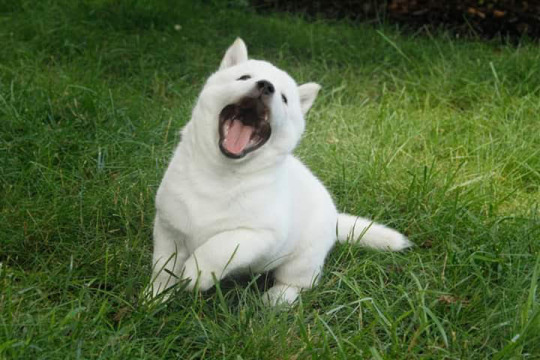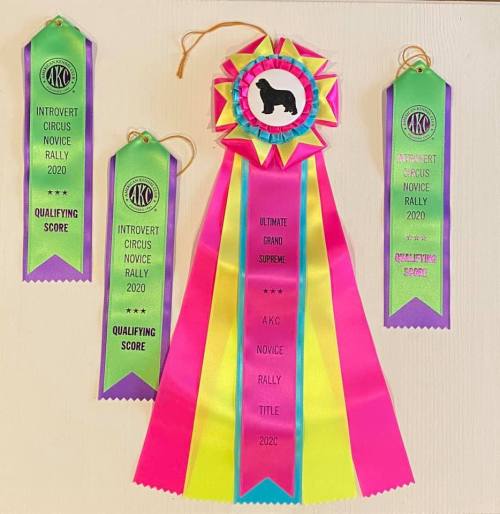#dog trainer

Some of you may have been wondering why the blogging hiatus. That’s because I’ve been extremely busy raising a litter of growlybiteyjumpy things, er– Hokkaido Ken puppies. Since two of them will be staying for at least another month until they can fly to their new homes, I thought I’d go ahead and share my tried and true methods for potty training.
Note: I’ll be using the term “puppy” in this post. However, this post applies to adult dogs just as easily!
The first thing you’ll need is a means of containment for your puppy. For now, start with a crate. All puppies coming from a responsible breeder or experienced foster home should have already been desensitized to being in a crate. If your puppy is coming from a shelter, pet store, or backyard breeder, I highly recommend starting with Susan Garret’s Crate Games DVD as quickly as possible. Crates should be just big enough for your puppy to curl up and lay down in. If the crate is too big, this will make potty training much harder because they will begin to designate a specific side of their crate for pottying in vs sleeping in. PUPPIES DO NOT LIKE TO POTTY WHERE THEY SLEEP! We’re going to work with this. Many crates these days come with wire dividers so you can gradually adjust the size of the crate to fit your growing puppy. If your crate does not come with such divider, using a cardboard box to divide the crate and gradually reducing the size of the box works as well! (Though you may have issues with your puppy chewing the box.)
Your puppy will need to be let out every hour during the day, and every time he starts to cry at night. Just because your puppy can “hold it” while he’s sleeping at night does not mean he can do the same during the day. When you let him out, leash him and take him directly to his potty place (typically outside, but I realize running down three flights of stairs if you live in an apartment isn’t always feasible; sod potty patches or piddle pads are also acceptable).
Leashing him does two important things:
- It builds a positive association between the leash and good things, and
- It helps him differentiate between potty time and play time
You should do minimal wandering with your puppy when you are attempting to get him to potty. Hold the end of a six foot leash. If necessary, you may take one or two steps in any direction, but no more than that. Give him five minutes to do his thing. Once he does, and wait for him to finish so you don’t cause him to STOP going, shower him with praise/treats while saying “Good GO POTTY!” Only after he potties should you unclip his leash (if he’s indoors or in a securely fenced in location) and let him sniff around or play for thirty minutes before putting him back in his crate.
This teaches him two things:
- “Go potty” is something he can do on cue, and
- The faster he goes potty, the faster play time comes
It’s extremely important to be consistent about your praise and your cues. If you start slacking off, the inconsistency will show.
When your puppy starts getting the hang of this, introduce an x-pen to give him more freedom. Place his crate inside the x-pen, along with the potty patch or piddle pad if you are going that route. If your puppy is successfully using the potty patch, gradually give him more freedom and start moving the potty patch closer to the door until your puppy will go to the door when he needs to potty.
Keep in mind that a puppy doesn’t have full bladder control until 16-20 weeks of age, sometimes later! Forgive mistakes, and never correct for “happy pee” (puppies eliminating themselves when excited). Remember that potty training is a long process, and while many puppies will progress very quickly using the methods above, there may still be accidents if you aren’t careful about supervising. If your puppy does have an accident and you didn’t catch them in the act, promptly clean it up with an enzymatic cleaner and avoid punishing your puppy for it. All punishment does is confuse a puppy and it can cause issues further down the road.
Still having potty training issues? Stay tuned for my next blog post on potty training troubleshooting!

Handsome





Some fun photos from the other night!
What does LIMA mean when it comes to finding the best trainer for you?
Whaaaat!?!? An Ethologist science based LIMA trainer actually standing up for *proper* prong collar use!?!
Yes. I’m 99% R+, but have been properly educated (& maintain ongoing training & education) in operant conditioning, classical conditioning, counter conditioning, and other training & behavioral modification methods.
YES I will only use a training tool that I have first tried on myself at MAXIMUM stimulation.
YES I use LIMA methodology and will exhaust / incorporate all other methods of R+, replacement reinforcement, & other B-mod methods before introducing / increaseing tools.
YES I train so that the tools are not needed long term. It is all about teaching the dog how to be set up for communication success! Think scaffolding on a building / sculpture. Eventually you want to see the finished piece in all it’s glory. FADING TOOLS IS IMPORTANT!
ANY Training tools (be it flat collar, harness, martingale, vibration, prong, verbal cue, sign language, body language, food, leash, etc) should be used to promote healthy communication - not punishment or feed frustration - to both ends of the leash!
NOT every training tool is for every dog. The tool is not magic and I get a disturbing number of behavioral cases from humans who thought they could just slap a prong on their dog and “fix them”. THIS IS WHY TRAINING TOOLS GET A BAD RAP!! 1) The dog didnt need fixing, they needed clarity of communication. 2) Now the uneducated but well meaning human made the issue 1000x worse and my job 1000x more difficult vs if they just sought professional help with their dog from the start.
.
Personal snobbery:
@hermsprengerusa are the ONLY prong / necktech collars I’ll use. Rounded tips. High quality strong metal that doesn’t bend, warp, rust, or otherwise deteriorate into a DANGEROUS piece of trash. Dont cheap out on your gear. It isnt worth the risk.
*not sponsored but I should be*
A well fitting collar (regardless of type) and leather* leash makes a world of difference. Toss those retractable leashes and ill fitting collars in the rubbish where they belong!
* I prefer responsibly sourced leather b/c it is better on my hands, ages well & lasts FOREVER, doesn’t give me rope burns, doesn’t dry rot / deteriorate into micro plastics like vegan leather.
Check out my tiktoks or insta (InglenookAcademy) for more!!

I see a lot of my professional dog training buddies bragging about how fine their dogs are on July 4th. I’m glad for you, and TBH my dog is too - but that doesn’t mean it’s because you or I are good trainers.Sure, training, thoughtful early exposure and counter conditioning helps. BUT what helps even more is a dog with a solid temperament (you can’t train that), and a hell of a lot of LUCK.
This is the first 4th of July without Charlotte - that dog taught me more personally and professionally than ANY temperamentally solid dog ever has. For weeks around July 4th she was highly medicated long lasting and fast acting crisis meds and she STILL was beyond being able to be comforted and was a serious danger to herself. No amount of training was ever going to “fix” that. I am so relieved there are no fireworks in heaven and she is not in agony today (at 8am i’ve already heard fireworks).
TLDR - dog people your dog’s successes and challenges don’t define you. Stop shaming people whose dogs are struggling. If you’ve never had a dog that struggles that tells me either you are lying, have culled your pack, or don’t have as much experience as you say you do. Don’t be elitist. Help others to keep their dogs safe while the country blows things up. Keep dogs inside and supervised and encourage/support others to do the same including seeking out medication if their panic is severe.
Sirius earned her AKC Novice Rally obedience title via AKC’s pilot virtual program— usually local clubs supply the ribbons. surprisingly AKC didn’t sell their own (like they do for some other programs) soooooo I took matters into my own hands and designed/ordered custom ribbons for Sirius to commemorate the title! Her ribbons arrived today and I’m thrilled with how they turned out! Pic with her after she’s had a bath
Post link
In this time of solidarity with the Black Lives Matter movement, many of us understandably feel compelled to be in the streets and so I wanted to offer up these dog protest safety tips:
1. DO NOT bring your dog to protests, rallies or demonstrations. Even if they are peaceful as we have seen repeatedly violence can and may break out. In addition, protests are loud, involve large crowds and are unpredictable which is stressful and frightening to dogs. You don’t want your dog to get injured or separated from you.
2. If you are a service dog handler and not able to safely participate in events without your service dog, please consider other forms of activism instead of protesting in the streets. Even if your dog won’t be worried about large/loud crowds, there is still a very real risk of injury to your dog from the police. Tear gas and pepper spray can wreak havoc on your dog’s nose, eyes, and paws.
3. If you are going to a protest, have a safety plan for your dogs at home. Plan ahead with a friend/family member who will be a support contact, who knows where you are going and if they don’t hear from you will go and get or go and stay with your dog(s). Make sure this person has keys to your home, knows your dogs medication, feeding and other routines etc. in case you are detained, injured, or arrested.
4. Support dog businesses (trainers, collar makers etc.) run and owned by people of color, particularly Black owned businesses. Stop supporting dog businesses that promote ‘blue lives matter’ racist ideologies.
5. Have conversations with your dog training friends and community about the importance of supporting Black Lives Matters.
6. If you have made the decision to not be in the streets for whatever reason, be available to be safety contact/caretaker for the dogs of your friends who are protesting.
This is a moment of great change and potential. Together working in all of our respective communities, I believe we can push for a better, safer and more just world.
http://sassafraslowrey.com/2020/06/2822/

